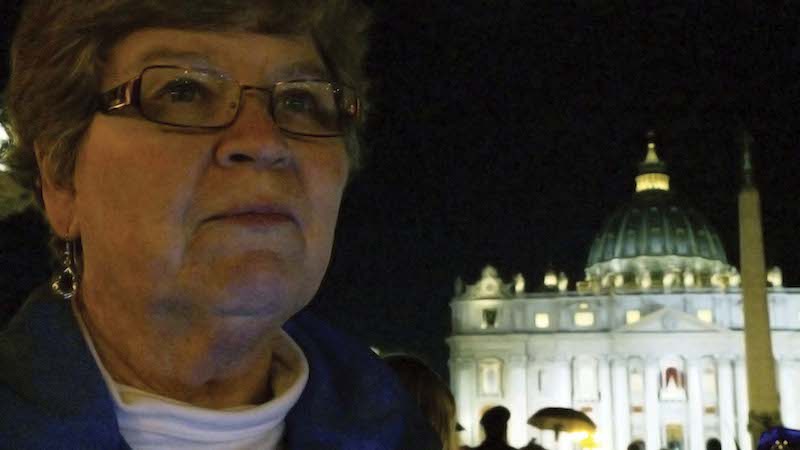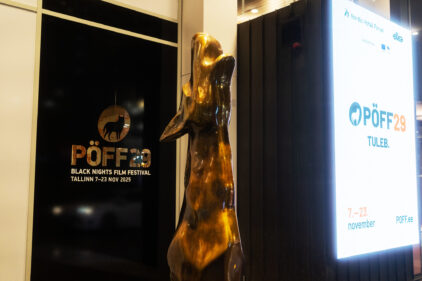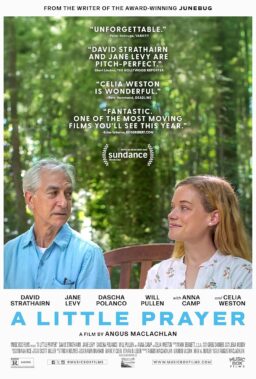Saturday at AFI Docs 2015 gave me a triple feature I won’t soon forget. At Washington D.C.’s Naval Heritage Center, I saw three films about revolutionary movements that have the potential to change the world. They are fueled by compassion and require their participants to take moral stands that may be widely unpopular in the eyes of society. I find it especially striking that these films about ruffling feathers are (like most of the pictures I’ve seen at this year’s festival) directed by women. At a time when female filmmakers are criminally undervalued in Hollywood, these movies offer inarguable proof of the tremendously talented women behind the camera that deserve to have as many opportunities as their male counterparts. If a man had made “Boys Don’t Cry” and “Monster,” rather than Kimberly Peirce and Patty Jenkins (respectively), his career would’ve taken off long ago.
Which brings us to the U.S premiere of Rebecca Parrish’s “Radical Grace,” an exhilarating portrait of the “Nuns on the Bus” that easily ranks among the year’s best films. Coming off like a real-life “Sister Act,” this heroic group of women rebelled against a Vatican-ordered censure by becoming engaged in social activism. When Representative Paul Ryan claimed his proposed budget cuts for services aiding the poor were inspired by his “Catholic social teaching,” the sisters decided to take their crusade on the road in order to do their part in ensuring that President Obama’s Affordable Care Act would be upheld in its entirety. After delivering a rousing speech during her first stop on the nationwide bus tour, the camera remains on Sister Simone Campbell as she sits back down and mutters incredulously to herself, “We have 14 more days of this? Holy s—t.” It’s in countless small moments like this one where Parrish’s film achieves greatness by humanizing its subjects rather than portraying them as one-note saints or martyrs. The late Sister Jean Hughes, who repeatedly brought down the house at the screening I attended, confesses how she finds herself slipping away from Roman Catholicism, while maintaining her spirituality and tireless need to help those around her (she insists on holding the door for others even while walking with a cane). An especially fascinating sequence follows Sister Chris Schenk on her trip in Rome as she visits various ancient sites housing artwork that illustrate the history of female involvement in the Catholic church conspicuously missing from the male-authored Gospels.
Enhanced immeasurably by a beautiful, wholly unobtrusive score from Heather McIntosh (“Compliance,” “Black Box”), “Radical Grace” moved me to tears with its portrayal of good people putting their beliefs into action in ways that transcend all idealogical boundaries. During the Q&A afterward, Parrish said that although she’s a nonreligious person, she does “identify as a spiritual seeker.” “What drew me to their story was how they demonstrated that social justice work could be approached as spiritual practice,” Parrish explained. “I realized that this idea was something that I could take into my own life and share more broadly.” The filmmaker had begun filming the nuns’ story before they even came up with the notion of stepping foot on a bus, and became all the more motivated to continue on their quest while watching Parrish “drag camera equipment around for three years.” Sister Simone and Sister Chris were present at the screening, and voiced their gratitude for the director’s achievement. “From our faith perspective, gifts are given before you know you need them,” Sister Simone noted. “This film, quite frankly, was a gift because it spreads the story out much further. […] We never directly took on the Vatican, we just did it in the shadow of the conflict that gave us all this press attention, and then used the press attention for our mission.”

When director Abigail Disney stepped before the audience to introduce her film, “The Armor of Light,” she asked festivalgoers to participate in a moment of silence to honor the recent victims of gun violence at Mother Emanuel Church in Charleston. Her subject, Evangelical minister Rob Schenck, had just spent the past day at the church and was understandably exhausted, yet still decided to be present for the Q&A to follow. The first act of Disney’s film interweaves the narratives of Schenck, a vocal anti-abortion activist who is rattled when various fatal shootings (including one at an abortion clinic) hit unsettlingly close to home, and Lucy McBath, a mother fighting for justice after her son is killed by a man who may evade punishment (a la George Zimmerman), thanks to Florida’s Stand Your Ground law. After McBath meets with Schenck, pleading for him to reconsider his stance on gun ownership, the minister undergoes a gradual moral awakening that he likens to sobriety. Once Schenck gets on the road to discuss his newfound belief in gun control with fellow Evangelicals, Disney’s film turns into a brilliant exploration of the appeal that firearms have for many white religious conservatives in America, and how that appeal is, in many ways, in direct conflict with their supposed beliefs. “So you need Jesus…and the Gospel…and a sidearm?” Schenck asks a pro-gun man of faith. The bravery and civility that Schenck exudes during these confrontations is astonishing to behold.
In between these tense discussions with church members, Schenck shares his evolving opinions in voice-over. He realizes that guns are an invitation for those operating them to give into their fear, that the notion of living one’s life with a constant defensive posture is inherently unhealthy and that the racial dimensions of the debate cannot be ignored. One of the most viscerally impactful scenes in recent cinematic memory occurs in D.C., as Schenck talks with three other pro-lifers and sees one of them go completely off the deep end, displaying the sort of short fuse that would make him among the last people one would want to see brandishing a gun. His fiery argument that less people would die if everybody was armed is calmly and eloquently demolished by Schenck, who says that such a black-and-white worldview indicates a detachment from reality. In an excellent sermon delivered toward the end, Schenck reminds his followers that Fox News and the NRA are not spiritual authorities and should never be blindly obeyed. The Washington Post’s religion reporter Sarah Pulliam Bailey moderated the post-film discussion, and boldly asked Schenck about his current stance on abortion, an issue that he and Disney have disagreed on, leading to the only moments of tension between them during production. Schenck says that while his opinion remains the same, making this film has brought him closer to understanding the perspectives of others and appreciating the complexity of their experiences. Though his activism has caused him to lose significant financial support, he has “come to the conclusion that some things are worth the cost,” and his recent visit to Charleston only affirmed his convictions. An unbridled “love fest” was taking place in the church in the wake of the tragedy. “No one told me that they wished there had been a gun fight,” Schenck replied, while visibly moved.

Just like Ron Schenck and the Nuns on the Bus, Larry Kramer has committed his life to creating a more humane world that values the worth of every life that inhabits it, and his activism is well chronicled in the HBO documentary, “Larry Kramer in Love & Anger,” set to air Monday, June 29th. Directed by Kramer’s longtime friend, Jean Carlomusto, the film covers territory familiar to anyone who saw David France’s Oscar-nominated 2012 doc, “How to Survive a Plague,” and doesn’t get quite as close to its subject as one would hope, yet the picture succeeds as a provocative study of the persona that the controversial writer and activist utilized in order to give AIDS victims the attention and care they deserved. What the film reminds us is that Kramer was not an especially popular figure among his fellow members in the gay community after publishing the 1978 novel, “F——ts,” in which he argued that the practice of “treating each other like meat devalues us as people.” Kramer stood for the dignity of his sexual orientation, promoting the importance of a loving relationship, and when the AIDS epidemic began to sweep the nation, his message of love took on an even deeper meaning. Ignored by their own government and left to die, gay men took to the streets in angry demonstrations led by Kramer in an effort to make visible the urgency of their plight and the necessity of research to find a cure.
Carlomusto does not sidestep the more difficult aspects of Kramer’s character, nor his current health problems. He may appear frail, but after having survived a liver transplant that nearly resulted in his death, Kramer still proves to be as resilient a warrior as ever (Carlomusto had arrived in D.C. just after visiting Kramer to celebrate his upcoming 80th birthday on June 25th). Joining her at the screening was Kramer’s enemy-turned-ally Anthony Fauci, an immunologist who was a target of many well-intentioned diatribes from the activist. “The demonstrations changed me,” Fauci recalled. “I learned from Larry that the FDA could be flexible with the rigidity of its process.” When certain figures in the government caught wind that Fauci had sided with the demonstrators, he got a call from the White House, causing him to fear that he would be fired. Instead, he became a key contributor in HIV/AIDS research, while Kramer grew to the status of an icon with his groundbreaking 1985 play, “The Normal Heart,” which was adapted for TV last year on HBO. By the end of “Larry Kramer in Love & Anger,” the activist is out of the hospital, newly married to his longtime lover and shows no signs of ceasing in his efforts to shed light on the untold history of gay people in America. Just as Sister Chris found visual traces of Catholic women’s history hidden in plain sight throughout Rome, Kramer has unearthed photographs displaying gay couples from past eras captured in loving embraces. Their story may be untold, but it has always existed, hidden in plain sight.












